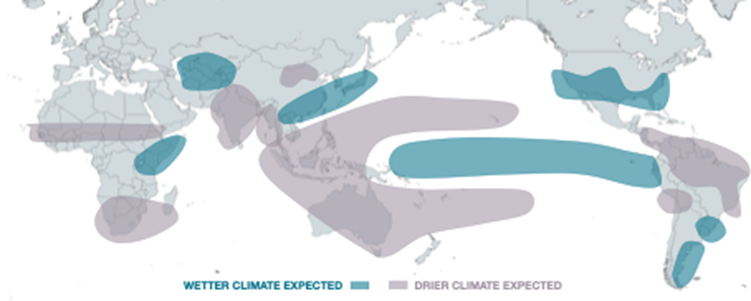Toon has a Master’s Degree in Civil Engineering (major in Energy) from the KU Leuven. He completed a 6 month internship as Derivates Analist. He work as a Junior Climate Consultant for Econopolis Climate and works on advisory projects related to climate & energy. Toon is also founder of Stroomloop, a unique trailrunning experience.
From Calm Waters to Economic Ripples: El Niño and the Pacific Ocean as Inflationary Forces
The Pacific Ocean, a vast body of water, covers nearly 30% of the Earth's surface. At first glance, it may seem unremarkable - its name originates from the tranquility experienced by Portuguese explorer Magellan in 1520 - but the temperature of its surface plays a crucial role in determining the success or failure of rice harvests in Southern Asia, and so much more.
Recently, researchers from the National Oceanic and Atmospheric Administration (NOAA) issued a warning that the Pacific Ocean has entered the El Niño-phase of its thermal cycle. Fishers off the coasts of Ecuador and Peru first coined the term "El Niño" in the 19th century to describe a warm water current that occurs regularly along the western coast of South America around Christmas time. The name "El Niño" translates to "the boy" in Spanish, a reference to the Christ child. During this cycle, the temperature of the Pacific Ocean near the Latin American coast is higher, while it is lower near Indonesia and Australia. Typically occurring every seven years, the "El Niño" phase is expected to persist until the end of the coming winter.
What Are the Implications of This Temperature Cycle on the Year-Round Weather Patterns?
Answering this question is challenging due to the complexity of predicting weather and climatic conditions. While significant progress has been made, there are still many factors at play. Despite uncertainties, researchers can make predictions based on previous El Niño years and the current available data. For the Australian continent, a drier and hotter climate compared to the previous year is expected. This raises the risk of wildfires, in a country that has already been the victim of significant forest fires in the past. Similar dry conditions are likely in India and the Philippines, where the monsoon season, crucial for successful rice production, is expected to be shorter. On the other hand, certain regions in the Americas, such as Argentina, Mexico, and the southern United States, are more susceptible to floods and heavy rainfall due to the reversal in direction of Pacific winds. Overall, El Niño contributes to an increase in the annual average global temperature due to the thermal energy that is released by the Pacific Ocean water mass.

Figure 1: Change in climate caused by El Niño. Data from Bloomberg.
On top of that, scientists anticipate that this year's El Niño will have a more severe impact due to the elevated temperatures caused by the ongoing global warming trend. The World Meteorological Organization mentions a 98% likelihood that the combination of greenhouse gas accumulation and the return of El Niño will make the next five-year period the hottest on record, pushing global temperatures to unprecedented levels.
What Measures Should We Take to Prepare for the Effects of El Niño?
Fortunately, the European continent is expected to be minimally affected by El Niño, apart from experiencing slightly higher temperatures, due to its geographical distance from the Pacific. However, concerns arise about the potential inflationary price hikes for food caused by El Niño's impact on harvests, which will also affect our continent. In a globalized economy, everything is interconnected, and this additional challenge will undoubtedly pose a headache for the European Central Bank (ECB) in taming the inflation. Countries closer to the Pacific, which have previously suffered from the direct effects and the reversal of Pacific winds during past cycles, have proactively allocated specific budgets to mitigate damages. For instance, Peru has announced plans to allocate over $1 billion this year to counter the effects of climate and weather. While this may seem like a substantial amount, it is relatively small compared to the estimated adverse impact El Niño has on global economic growth. Research published in Science by the Dartmouth Earth System reveals that the 1997/1998 El Niño resulted in a $5.7 trillion decrease in global GDP, and projections indicate that the accumulated cost over this century will reach $84 trillion due to the amplification effect of climate change.
While El Niño is a natural phenomenon that is likely to contribute to an increase in global temperatures, it emphasizes the importance of significant investments in clean technology to mitigate the additional damages caused by climate change. Such investments will yield positive long-term returns by helping to alleviate the costs associated with crop failures and floods. When looking at the analysis of the Dartmouth researchers, an exemplary situation where clean energy can reduce future climate damages by ten percent, would result in avoiding a future cost of $8.4 trillion. The recent report from the International Energy Agency (IEA) on energy investments indicates that global funds are flowing in this direction, with a record-breaking $1.7 trillion invested in clean energy technology last year. These substantial investment figures remain necessary to counteract future damages. However, the possibility of breaking a new record this year becomes less likely if a significant portion of the funds is directed towards adapting to climate shocks related to El Niño. As we look ahead to the following year, an exciting comparison awaits us—the correlation between Pacific Ocean temperature and its consequences for the funding of the energy transition.
